
Nemalion vermiculare
Rubber Threads, Sea Noodles
14 July 2022
Wickaninnish Beach, Pacific Ocean, outer coast of Vancouver Island, B.C., Canada.
Tide: -0.3 feet at 07:49 PDT (measured at Ucluelet Tidal Station)
Conditions: Overcast, calm, sea smooth to rippled, low westerly swell, humidity 90%, 11˚C.
Moon: Waning Gibbous (98.4%, 16 days); Previous Phase, Full Moon, 13 July 2022 at 11:37am PDT: Next Phase, Third Quarter, 20 July 2022 at 7:18am PDT.
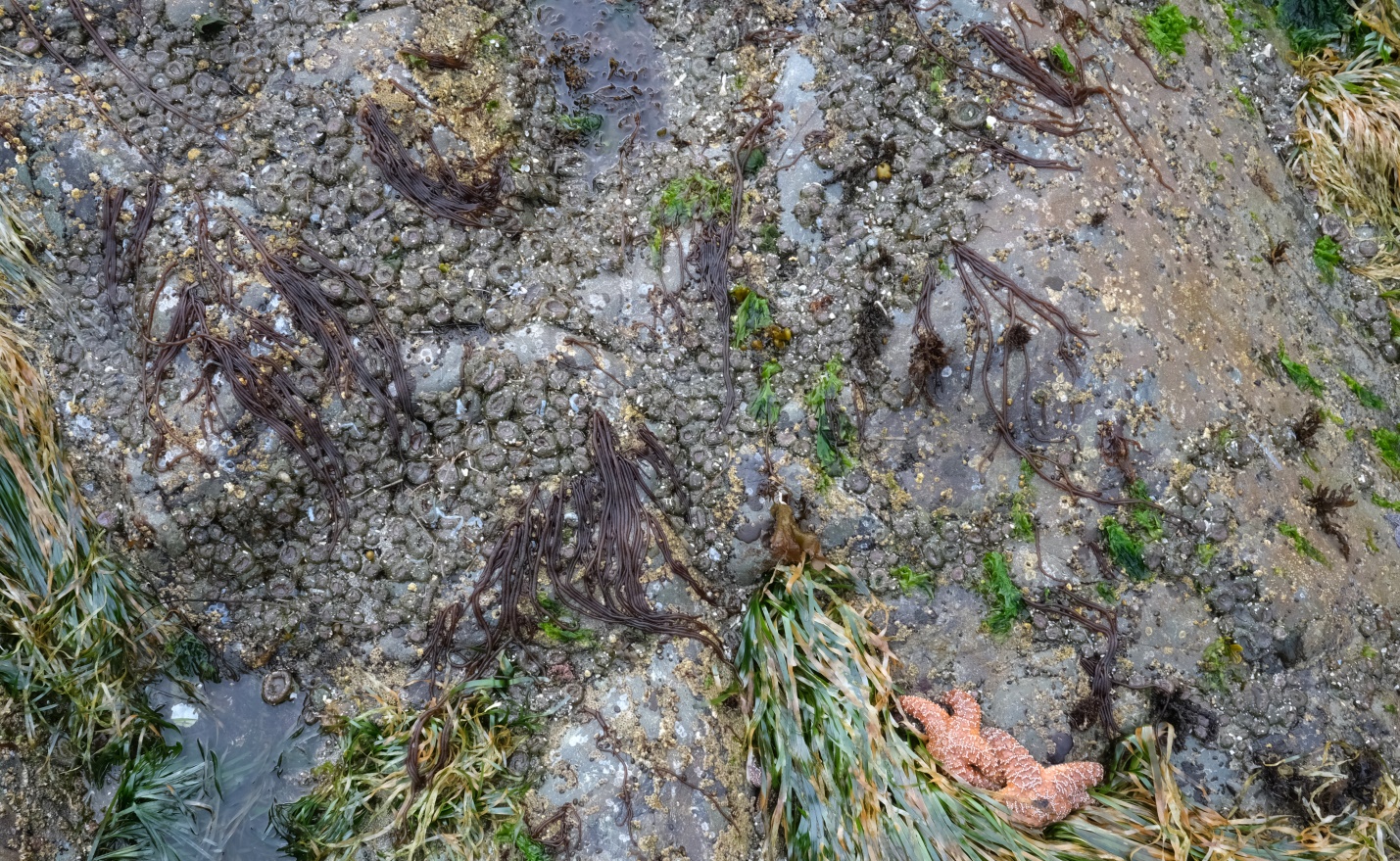
Figure 1: Several clusters of Nemalion vermiculare, Rubber Threads, are pictured here on the rocky substrate at Wickaninnish Beach. Clumps of Common Eelgrass (Zostera marina) grow from crevices in the rock, sea stars and aggregating anemones also enjoy the territory. Some scraps of bright green ulva and a few mastocarpus species fill in the algal cast list, but the main ‘player’ here from the seaweed world is Rubber Threads. Wickaninnish Beach, outer coast Vancouver Island, B.C., Canada. July 14, 2022. Photo ID: 27245 ©Seaweedwhisperings.com
Person 1:
Weak.
Wimpy.
Poor Competitor.
Uniform in coloration – purplish gray.
Shiny tubes look like: one, earthworms, or two, Japanese soba noodles.
We hadn’t seen you for certain previously, but you stand out now.
You like to grow where there is bare rock and no competition from other seaweeds.
I wonder if last year’s die-off of barnacles and mussels has given you your best chance of thriving in years.
Each thread is quite uniform in diameter.
I’m more interested in looking at you rather than getting to know you.
Your form is unusual for a seaweed.
Do I want to get to know you? Not sure.
You are slimy looking, but definitely rubbery to the touch.
You drape down over the rocks, flaccid, limp, helpless. No motivation to be otherwise.
Perhaps it’s this lack of motivation that repels me – why bother interacting if you are going to be a “helpless mass of noodles”?
What are your strengths?
Do you have any?
Perhaps you have the patience to wait for optimum conditions to thrive.
Don’t feel that you have to force your way forward or to actively compete with others.
Maybe appearing helpless to others is irrelevant to you. You actually are NOT helpless, just waiting for the right time to “come alive”.
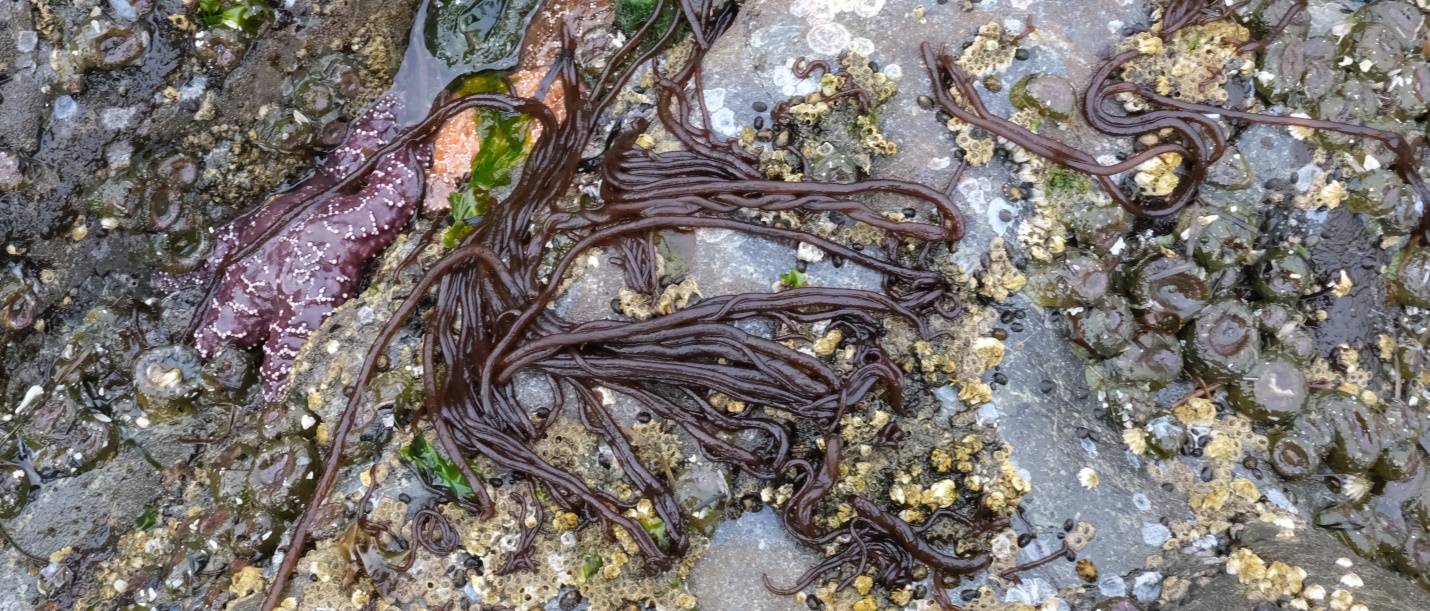
Figure 2: A closer look at a few clusters of Rubber Threads; affixed to rock by small cushiony holdfasts, this worm-like alga keeps company with barnacles and other marine invertebrates. Wickaninnish Beach, outer coast Vancouver Island, B.C., Canada. July 14, 2022. Photo ID: 27246 ©Seaweedwhisperings.com
Person 2:
After having started our explorations at the lowest tide levels this morning, I left the sand rimmed lower boulders and worked my way up the rocky protrusions and large outcrop here, up to the higher intertidal regions and a very different arrays of seaweeds. A Pisaster ochre – a strong and healthy looking sea star, (so good to see after years of low populations due to the wasting disease that impacted these creatures severely), caught my attention. I went over to look and observed more closely. It was then that I exclaimed, “Oh, it’s Nemalion!” I felt a surge of delight as this is a seaweed that is not common to come across.
I recall that I felt genuine delight and as I wrote out my notes about this encounter – d e l i g h t , yes it was delightful and the thought crossed my mind, “Do you enjoy the gratifications and pleasures and delights of life, too, Nemalion? Is ‘delight’ one of the states of being that you are well acquainted with?”
Quite satisfied to have enjoyed the first few clusters of smaller Nemalion vermiculare that I had found, I went on exploring the area and found another cluster, then a few more, and then yet another area that was abundantly populated with this distinctive looking alga.
The circumstances here, at this season and place, seem to be just perfect for Nemalion.
Distinctive looking indeed. None other looks anywhere similar.
Long, narrow, a bit roughly formed (at close inspection), solid yet gummy looking cylinders that are a deep red brown / purplish brown and grow in clusters from bare rock or barnacles.
Younger ‘threads’ are thinner and shorter; longer ones have a larger diameter and can be much longer.
Once growth really gets going, though, length seems to be the dimension where the most effort is put. When young, the threads are the most curved and seemingly playful or still experimenting with their shape. Age seems to trim that away resulting in the rather consistent ‘long threads of rubber’ look. And like rubber, the threads do not take sharp turns or bend back on themselves; any change of direction the thalli make is a gentle one.
The tips of each Rubber Thread are tapered to a blunt point; this is reminiscent of earthworms. Field guides hint that some observers mistake this alga for a worm-like marine animal. It is interesting that in the areas where we found it today the most numerous ‘neighbors’ for Nemalion were indeed animals – colonial anemones, sea stars and barnacles. Is this some sort of disguise this seaweed uses – pretending to be an animal?
The main thallus rarely branches, and I only found one or two examples of this. Also the long thalli seem to be remarkably tangle free. In some areas they are left in a bit more of a hodgepodge of orientations, but only one or two times could I find two ‘threads’ tangled around each other.
Seen from a bit of a distance Rubber Threads aren’t really very noticeable, they just blend into their environment.
Seen a bit closer the long thalli have a smooth, matte-looking type of wetness and also a depth that feels notably solid. Somehow at this distance the look to this seaweed seems somewhat ‘elegant’ or ‘graceful’ – these words are not quite accurate but it is the best fit for the effect of how the ‘threads’ seem to gently lie, stranded out of water at low tide, in long lines, often side by side for part of their lengths, then sometimes curving gently off here and there. There’s a feel to this kind of grouping that is of a “settled companionship”. They appear to do well together and there is a sense of contentment, maybe even peace. Yes, noticeable to them here today is the absence of struggle, strife or competition to the arrangement of the groupings / clusters. The ‘threads’ rest just where the last bit of water action left them, and they have no complaint with that whatsoever.
Then, viewed even more closely, one can observe that these cylindrical tubes of solid alga are rather irregular – they’re not perfectly formed at all. BUT there is an interesting sense that this form you take is, to you, totally “perfect enough”, Nemalion. Or maybe your form was once closer to perfect and now it is just a touch aged and worn? It reminded me of a novice potter working with clay that has rolled out some cylinders and felt simply delighted by the result of their initial attempts. It’s a feeling of: this is good, this works, ok, let’s keep on now. There is a beauty in simplicity and this seaweed embraces that without shame and feels no indignity whatsoever.
It’s a trait that is not very commonly encountered, a sense of “I’m just fine the way I am” – and this feels rooted in the energy of this seaweed. There is no trace of self-consciousness about any ‘irregularities’ or ‘imperfections’, and there is no feeling of needing to improve or polish or enhance themselves.
There’s a type of confidence to this seaweed that was not ‘worked at’ or ‘built up’, or ‘learned’ – not at all. In fact, I don’t think there’s much awareness of this quality named ‘confidence’, instead it is purely an integral part of who Nemalion is. Like a “happy coincidence”, this easy assuredness is a natural expression of how Rubber Threads meets the world. They trust in it; it is who they are.
Interestingly, when I was preparing my photo file and a second chair beside mine for Person 1 to sit in, when I put the additional chair there and it was empty I felt “crowded” by it. We’d done this same thing two previous days this week and I’d not noted this crowding at all. Then, even more interestingly, when Person 1 sat down beside me, and this same chair was no longer vacant, the crowded feeling dissolved, it disappeared totally. How strange this seemed and how very explicit as well.
So, I think I experienced a bit of the Nemalion way of being. Nemalion vermiculare truly enjoys close companionship with their fellow Rubber Threads. This is how the “world feels right” to them.
Upon noting this experience I recalled that I don’t think I’ve ever come across a depiction of this seaweed, either as an illustration or a photograph, as a single Rubber Thread; being solitary is simply not their way, not at all.
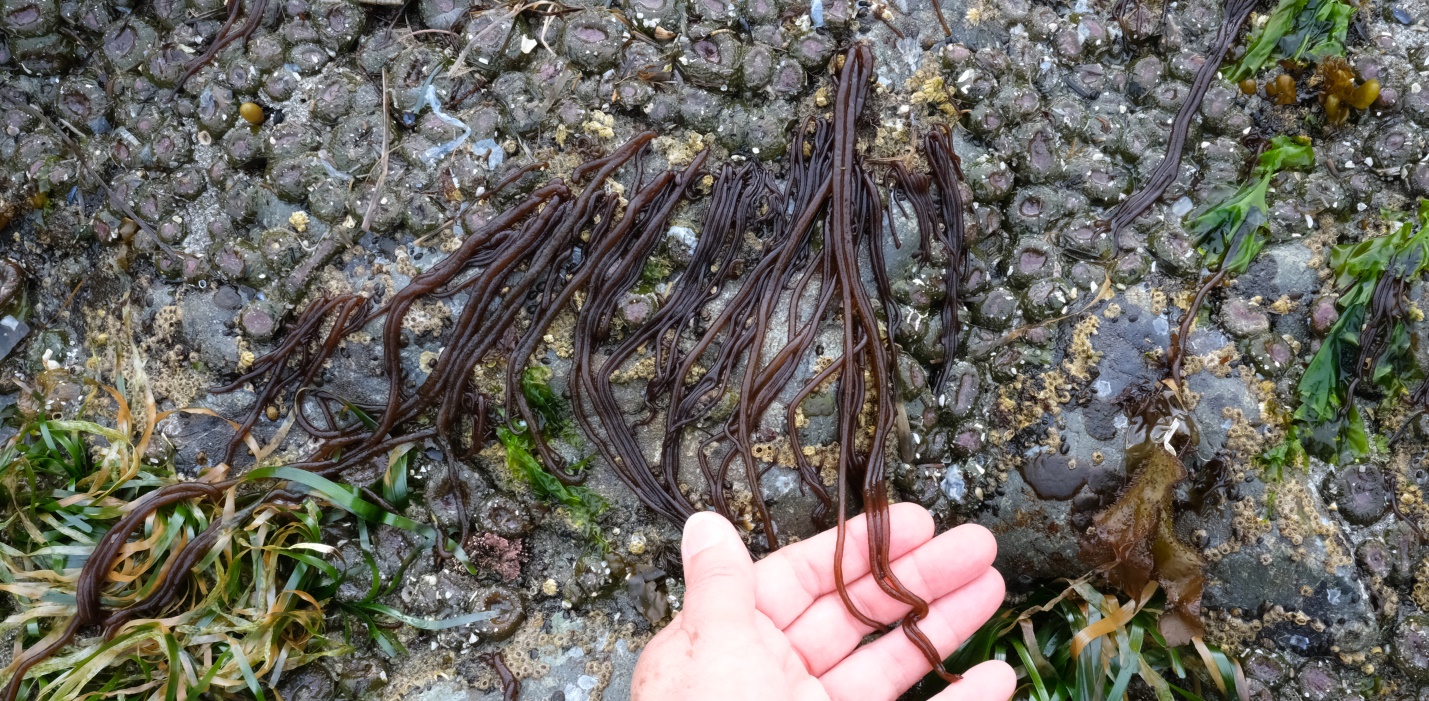
Figure 3: Rubber Threads ‘in hand’ give size reference. These rubbery cords of algae do look worm-like when shorter, but as they grow in length, the ‘Sea Noodles’ common name is more apt. In this location and on this particular year, the Anthopleura elegantissima (Aggregating anemone), are notably abundant. They look like circular ‘tiles’ in this picture and their ability to reproduce asexually has helped them carpet this rocky area almost completely. Wickaninnish Beach, outer coast Vancouver Island, B.C., Canada. July 14, 2022. Photo ID: 27247 ©Seaweedwhisperings.com
Discussion:
It is clear that Rubber Threads enjoy sharing company, but this is sharing company with their own kind. This is partly how the peaceful and contented compatibility comes about – there are few dissenting ideas and also little unfamiliarity. When similar values are shared, it is easy to enjoy one another; nothing new has to be learned or integrated as the group already shares common ground.
Some of the peaceful contentment in this seaweed also comes from the very simple form it has evolved to take. When exposed and out of water, it doesn’t flatten; the thalli are indeed solid, but they also have a look as if they contentedly settled wherever the last wave and forces of gravity left them. They are of notable size and rounded so they don’t bunch up on top of each other but literally and figuratively “roll off” of each other to lie side by side. Side by side rather than on top of or beneath – these are very different energies. When immersed in water it is easy to imagine these same thalli being happy to float and move just as the water level and currents direct them. There is no indication that they would or could resist – and maybe that is a kind of ‘wisdom’ as, who can resist the movement of the ocean tides anyway? It may also be something more than wisdom alone. As I sit with that feeling of Nemalion’s rubbery threads moving under and with the water…, it feels comfortable, agreeably pleasurable, it is something to simply ‘fall into’ and enjoy. Again, there is nothing to do about it! It is “perfectly enough” to know and trust in one’s own qualities and then give over to the forces and movement of the water with the conviction that “all is well”.
The concepts of ‘roll off of’ and ‘falling into’ and the solid rubbery texture of this seaweed are interesting to think about. There is a benefit in being rubbery – when one falls one is likely to bounce or rebound back in place and to remain mainly unharmed. Left to lie atop a rock at low tide, there is enough strength and solidity to the rubbery thalli of this seaweed that it holds its shape out of water, and despite its gummy look, things roll off of this seaweed – they don’t pile up on top of it. It’s an interesting blend of qualities.
Rubbery, though, can also be a limiting factor; there is the problem that one can become a bit ‘stuck’ with certain ways, aligned with old preferences, and also not be quite malleable enough to take in ‘the new’. One bounces back, and ‘back’ means to where you started from. The ‘falling into’ or the action of dipping or swaying in the ocean does not lead to collision, impact, wounding, pain or other motivations that might stimulate change. It is as if Nemalion has worked out a way to stay very much who they are and they prefer to maintain that, rather than wander into any unknown or new areas where they may not be, at least initially, so successful.
Person 1 first described the aspect of lack of resistance and giving over to and ‘moving with’ stronger forces a wimpy quality, a type of weakness. Person 2 was moved to describe the ‘looks’ of the seaweed from three different distances. We considered some of these aspects once more and now see that they seem to serve one result, they fail to give the true impression of Nemalion; they’re almost like a contradiction or a disguise or concealment. There is an external look to this seaweed that can belie the inner energy and vice versa. Nemalion looks a bit imperfectly formed or simply not very mindful of its “looks”. The outside may look weak or like a helpless ‘bunch of wet noodles’ but that is far from the whole story. Inside Rubber Threads are not so casual at all. The inner values of sharing together at a season and time of plenty are strong and firmly in place and they know how to accomplish this. With Nemalion there is an unshakeable conviction, borne of their experience and the way they have come to live their life, that there is abundance to enjoy and with that little need to compete for simple survival.
This theme, external look failing to give a true impression of the whole character, is also found in the ‘elegant/graceful’ look that Person 2 described. Days after her initial observations she took another quick glance at photographs of the very same groupings of Nemalion that she had been interacting with in situ, and laughed aloud to think that if you didn’t ‘fill in’ the look of this seaweed with the knowledge of its energy, you wouldn’t find descriptions like graceful or elegant or easy compatibility. So, here again is another example of the contradictions that make up this seaweed. One way that can play out is with language and conversation. For this type of individual, sarcasm or satire can be a way they present their ideas in ‘camouflage’, so to speak. The true meaning of what was said is puzzling to interpret or at very least requires interpretation and to an ‘outsider’ this is quite difficult. It is notable that there doesn’t seem to be deliberate calculated effort in creating this ‘disguise’ or concealment; that is not the intention we could sense in this seaweed’s energy. The ‘disguise’ aspect arises from two main aspects. First is that for Nemalion it is their innate ‘second nature’ to present in what we are calling contradictory or concealing or disguised ways. Second is that the span of characteristics Nemalion embodies is really quite large, and if viewed from only one pole, very differing. An outsider first meeting Nemalion could easily jump to some conclusions or presume they understand a bit about them, but our experience is that could easily be inaccurate or at least very incomplete.
Strong with this seaweed is the concept of shared understanding and acceptance that comes from being grouped with / aligning with like-minded others – they all “speak the same language” is another way of putting it. All are ‘known’ to each other and there’s no need to dress up or ‘put on airs’, although to outsiders that may seem very much like what they do. So, there is also little social competition here; if you are part of the Nemalion ‘group’, well, you’re in, and that’s that. There is plenty, abundance, no need to truly compete with each other.
There are of course some limitations to the companionship preferences though. There is not really much comfort in ‘going it alone’ and this is one area where Nemalion could accurately be described as “weak” and if not actually “helpless” certainly rather low on courage. Going it alone could mean confronting new and unexpected things and demand changes or modifications in their way of being and other adaptations, and they would not be able to reach out just at their side to their “fellow Nemalion” to help them with any of this. Nemalion is comfortable the way they are…, feels it is actually very good being just the way they are…, therefore, why would they want to change that, risk that, lose that? Independence or breaking out on their own is not sought because they don’t feel constricted by the boundaries and definitions of their group; they feel agreeably secure and contentedly successful within those boundaries. Like Person 1’s observations of this seaweeds’ nature to drape down limply over the rocks, Nemalion, unlike numerous other seaweeds, does not attempt any struggle or opposition to the rules of gravity. There is an acceptance of certain boundaries, limits, conditions or rules and, by virtue of this acceptance, Nemalion works out their best options in life and is truly quite satisfied with the results.
Another limitation to the comfortable companionship is that it seems to be limited to “like-minded” others or to keeping to their “own kind”. This can bring about the sort of situation where there is not much innovation, not much new that can be introduced, not too much deviation from the known and “tried and true” is tolerated. There is notable “discomfort” actually if dissenting ideas, discordant thoughts, or even simply suggestions that are excessively exploratory are somehow introduced. These things are unwelcome, uninvited and unwanted. Possibly a bit of subtle change may be played with from time to time – for entertainment purposes, but the strong tendency is to bounce back to what was already known and habitual for Nemalion. So the companionship that thrives does so within the domain that has been clearly established and is invariably maintained for continued enjoyment of the same. There is an inherent tendency to avoid the unknown or any truly new territory and to reject potential companions who might introduce this – Nemalion knows that it is rare to be both a novice and confident; they distinctly prefer the latter.
When thinking of and writing about this seaweed there was the urge to use the plural pronouns – they, them and their, and this was not a conscious effort to be gender neutral, but rather because it was really impossible to think of only one Rubber Thread. Although the plurality of their nature was behind the word usage, upon review the concept of this seaweed being neither strongly female nor strongly male is there also. This is not to say that Nemalion is asexual; sexuality is present but it is more that this is another area where the physical or external look does not reveal the inner characteristics.
Just as the ‘threads’ of Nemalion are solid, there is a depth to the contented confidence of their energy. External perfection is not what they are about; that could be the “disguise of looks” such as being gold-plated rather than solid gold. Nemalion is solid and consistent throughout, and their outer looks, well, those need to be sufficiently suitable, “perfect enough” to serve their function well, but these outer trappings are never more important than the core. Gold nuggets come to mind as being physically quite ‘rough or crude’ and interestingly gold is rarely found in its pure form; usually nuggets of gold are alloyed with other metals. Is this seaweed in some way working out that issue? Does Nemalion work to improve their purity by expelling that which is foreign? Does this process delineate their success?
It is apparent, though, that Nemalion truly knows their way. They don’ try to be all things to all others…, but within their group or community Nemalion has long ago found their way, enjoys great success with it, and is steadfastly sticking to it. They do so with a mix of confident convictions and gratified contentment that is unmistakably evident.
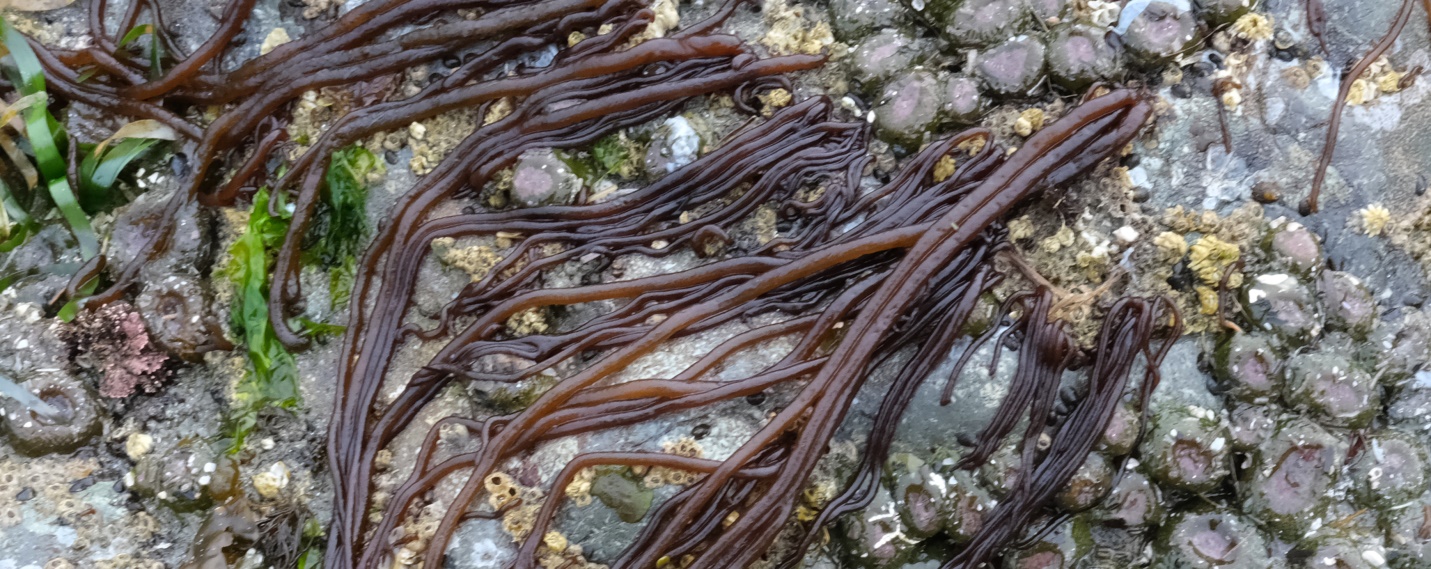
Figure 4: A closer look yet shows Nemalion vermiculare at various ages and stages of growth. Wickaninnish Beach, outer coast Vancouver Island, B.C., Canada. July 14, 2022. Photo ID: 27248 ©Seaweedwhisperings.com
Biology & Natural History Information:
Description:
The gametophyte of these red algae resembles long smooth worms or cooked noodles. Their color ranges from deep purple or black to golden brown but is usually reddish-brown. Texture is soft but solid and the rubbery cords usually grow in clumps or clustered together. The thallus is typically unbranched, and if any branching does occur it is not near the tips. This seaweed affixes to rocks by a small cushion-like holdfast. It can grow to lengths of 45 cm but often not much more than 20 cm; diameter of these cylindrical algae can be up to 5 mm and usually not less than 2 mm. The sporophytic (spore producing) stage is microscopic. The worm-like plants are the gametophyte stage and in most cases both sexes occur in the same plant. Gametangia are internal and not obvious.
Habitat:
On rocks of exposed shorelines; high to mid-intertidal zone. This is a true spring/summer annual. It makes a fleeting appearance, in the gametophyte phase, sometimes only for one month.
Distribution:
Its eastern Pacific range extends from northern Alaska to northern Mexico; it is also found along coastal Japan, Australia, New Zealand and the North Atlantic. Although the distribution of this seaweed is really quite extensive it is not very commonly encountered, again, largely due to its short gametophyte season.
Remarks:
This seaweed is commonly misidentified as a wormlike invertebrate. The former name of this species, helminthoides is also suggestive of the worm-like nature; helminthoides, is from the Greek – like a parasitic worm (helminths).
Classification:
Phylum: Rhodophyta
Class: Florideophyceae
Order: Nemaliales
Family: Nemaliaceae
Genus: Nemalion
Species: Nemalion vermiculare Suringar 1874
Former name(s): Nemalion helminthoides, Nemalion elminthoides.
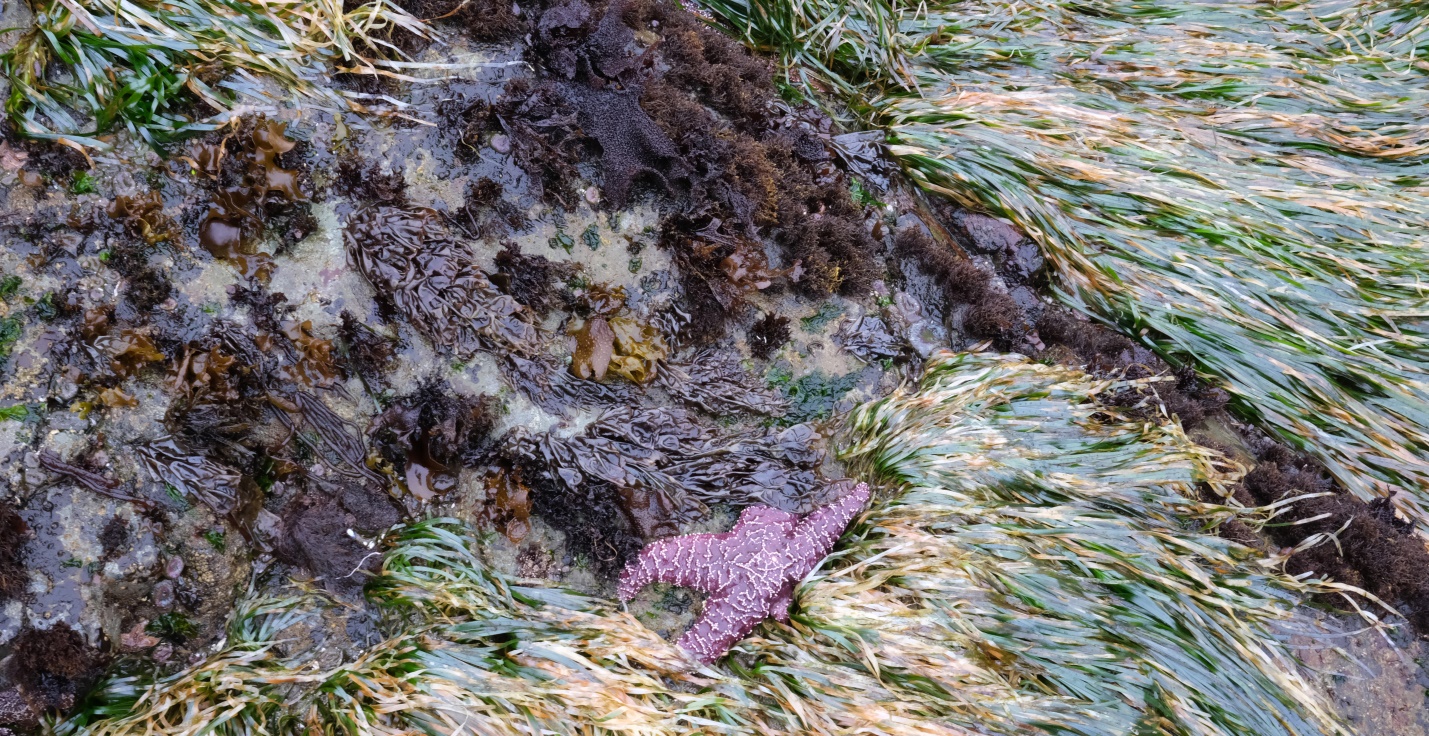
Figure 5: This is the original Pisaster orchre sea star that drew Person 1’s attention to the area where Nemalion vermiculare was also living. Two clusters of Rubber Threads are visible in this overall habitat shot (to the left and slightly above the sea star) and growing also in this higher intertidal region are blankets of eelgrass, plus some Laver, Nail Brush, Tar spot/Turkish Washcloth and Sea Lettuce algae. Wickaninnish Beach, outer coast Vancouver Island, B.C., Canada. July 14, 2022. Photo ID: 27249 ©Seaweedwhisperings.com
![]()